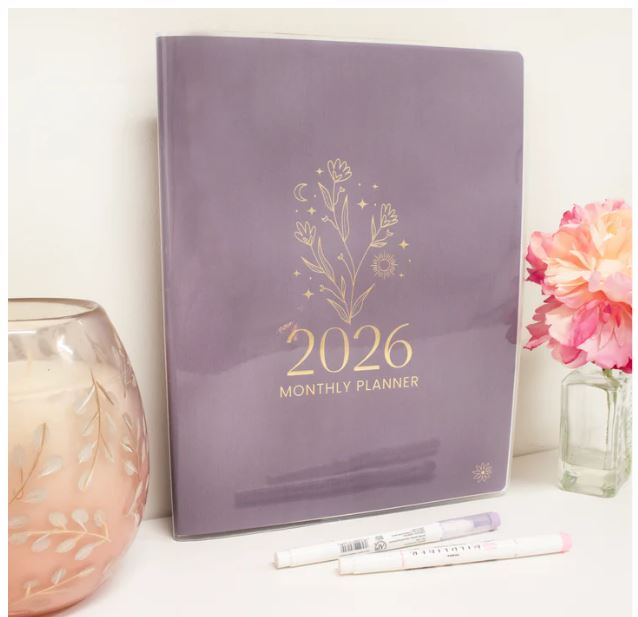Some planners look great on the shelf, but once you start using them, they feel off. It might be because the layout doesn’t match the way your week actually runs. You might be someone who thrives with structure or someone who just wants an easy view of the month. Either way, choosing a planner format should be less about trends and more about how it fits into your life.
This blog breaks down the difference between weekly and monthly formats, especially in the context of a 2025-26 planner weekly and monthly, so you can figure out what helps you plan without pressure.
Weekly Planners: Day-by-Day Without Missing a Beat
A 2025-26 planner weekly and monthly gives you both types of layouts, but let’s start with the weekly view. Weekly planners are all about structure. You get space to plan each day—great if you like mapping things out in detail.
If your weekdays are packed with meetings, classes, appointments, or even errands, a weekly layout helps you stay organized without having to cram things into the corners of your brain. The visual breakdown lets you split your time more easily, and for people who like routines, this format works well.
Many also use weekly planners to track things outside of work like meals, workouts, or screen time. You’re not just scheduling tasks but also paying attention to patterns. That can help you make better decisions about where your time goes.
Still, if your days don’t always follow a strict routine or if you don’t have that many time-sensitive things going on, a weekly planner might feel too detailed. That’s when monthly planning can feel lighter and less demanding.
Monthly Planners: See It All Before It Happens
Monthly formats offer a wide-angle view of what’s coming. Instead of focusing on each day, they show you how your month is shaping up. You can space out your commitments, see deadlines ahead of time, and notice if a certain week looks too full before it hits you.
If your schedule shifts a lot or if you’re working on long projects, the monthly layout keeps things visible without overwhelming you. It’s also helpful for setting goals. You can use it to sketch out major milestones and then revisit the page throughout the month to stay on track.
Some people like the simplicity of it. You jot down important dates, maybe add a few notes on the side, and that’s it. You’re not locked into any structure, which works well if your days change often or if you don’t need to track everything closely.
But monthly planners don’t give much space for the small stuff like your grocery list or a detailed to-do. So they work best when you only need to keep tabs on the big things.
Different Planning Styles Call for Different Formats
Start with how you naturally organize your time. If you’re someone who likes breaking things into steps and checking things off day by day, a weekly planner probably fits your rhythm. It helps you map out workdays, tasks, and personal goals without missing a beat.
On the other hand, if you like knowing what’s ahead but don’t need to schedule every hour, the monthly format keeps your plans light and flexible. It’s great for tracking big dates, deadlines, travel, or monthly habits like budgeting or cleaning routines.
You can also use both. Some people write big-picture events in the monthly view, then use the weekly section to plan out what needs to happen each day. That way, you don’t lose sight of long-term goals while still keeping up with daily tasks.
How to Switch It Up Without Losing Flow
Sometimes your planner needs to change with you. Maybe one month feels packed and you need to go week by week. Then summer rolls around, and you only need to mark a few things here and there.
You don’t need to commit to one format forever. If you’re using a hybrid planner, you can shift between views based on what’s happening in your life. Use the monthly pages to sketch out your month, then open the weekly layout when you need more space to think through your day.
The trick is to not over-plan. Start with what’s important, then build around it. The planner is there to hold your ideas, not to add pressure.
The Planning Habit
Any format you choose will only help if you use it. Try setting a regular time to update your planner, maybe on Sunday evening or the first of the month. You don’t need an elaborate setup. Some people use color coding, while others stick with a single pen.
You might also want to pair your paper planner with a digital calendar for quick reminders or changes. That way, you’re not checking one thing all the time but still have a full picture of your week or month when you need it.
What matters most is that the habit feels doable. When you get into the flow of using it regularly, planning feels less like a chore.
Find Your Planning Flow for the Year Ahead
A good planner helps you keep track of it in a way that makes sense to you. The right format depends on how you think, work, and move through your days. If you’re working with a 2025-26 planner weekly and monthly, you’ve already got flexibility in your hands, and you just have to figure out which view suits you best.
Planning, at its best, isn’t about filling every box. It’s about giving your days a bit more shape and your mind a bit more space. Over time, that rhythm can become something steady you carry with you, even when your schedule keeps changing.



